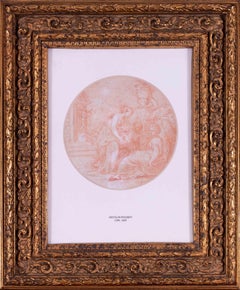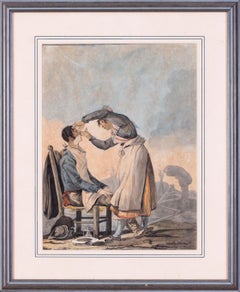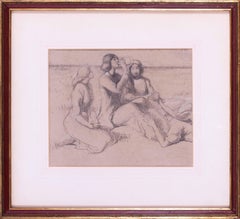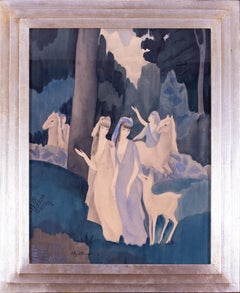Want more images or videos?
Request additional images or videos from the seller
1 of 8
Francesco Zuccarelli RAItalian 18th Century red chalk study of a seated man by Zuccarelli
$2,067.92List Price
About the Item
- Creator:Francesco Zuccarelli RA (1702 - 1788, Italian)
- Dimensions:Height: 11.13 in (28.28 cm)Width: 7.63 in (19.39 cm)Depth: 1 in (2.54 cm)
- Medium:
- Movement & Style:
- Period:
- Condition:Foxing and surface dirt, behind glass, float mounted with gilt and washlines, further mounted and in a gilt composite frame with chips, minor losses and abrasions.
- Gallery Location:Petworth, GB
- Reference Number:1stDibs: LU540312131232
About the Seller
4.9
Platinum Seller
Premium sellers with a 4.7+ rating and 24-hour response times
Established in 2010
1stDibs seller since 2017
272 sales on 1stDibs
Typical response time: 2 hours
Authenticity Guarantee
In the unlikely event there’s an issue with an item’s authenticity, contact us within 1 year for a full refund. DetailsMoney-Back Guarantee
If your item is not as described, is damaged in transit, or does not arrive, contact us within 7 days for a full refund. Details24-Hour Cancellation
You have a 24-hour grace period in which to reconsider your purchase, with no questions asked.Vetted Professional Sellers
Our world-class sellers must adhere to strict standards for service and quality, maintaining the integrity of our listings.Price-Match Guarantee
If you find that a seller listed the same item for a lower price elsewhere, we’ll match it.Trusted Global Delivery
Our best-in-class carrier network provides specialized shipping options worldwide, including custom delivery.You May Also Like
A Study for the Angel of Saint-Severin church in Paris, by Paul Flandrin
Located in PARIS, FR
After the restoration of the Saint-John chapel’s frescoes at the Saint-Severin church in Paris in 2022, the drawing presented here is a moving testimony to their creative process. It...
Category
1840s Old Masters Figurative Drawings and Watercolors
Materials
Chalk
$4,214
H 15 in W 11.38 in
A dazzling Venetian Regatta Boat Study attributed to Alessandra Mauro
Located in PARIS, FR
This stunning Baroque study depicts a regatta boat, a type of vessel developed in eighteenth-century Venice for the regattas organized by the Serenissima during visits by royalty and princes. We propose to link this drawing to the work of Alessandro Mauro, an artist who specialized in this type of composition, as illustrated by a drawing from him at the Metropolitan Museum.
1. Description of the boat
The greatest decorative fantasy reigns in this preparatory study, which blends mythological and exotic elements with references to ancient Egypt. Our drawing is probably an initial thought, destined to be refined and clarified later in pen and ink (as evidenced by the ink stain in the lower right). A quadriga of seahorses guided by Neptune stands at the stern of the boat, shown well above the waterline (perhaps to outline its empty volume). One of the seahorses is ridden by a newt, while Amphitrite lies at the feet of the sea god.
The center of the boat is occupied by a vast baldachin resting on four atlantes and surmounted by a figure riding an animal (a dragon?). Three figures sit beneath the canopy, one of them on a griffin-shaped seat. This allusion to Egyptian antiquity echoes the winged sun (sometimes a symbol of the god Horus, as in the temple of Edfu in Egypt) that adorns the sides of the promontory on which this baldachin rests.
Another flag-bearer figure crouches at the stern of the boat on a raised seat, on the reverse of which is a crowned mermaid whose arm, extended backwards, rests on a mascaron decorated with a radiant face (Helios?) and whose torso surmounts an elephant's head. The heads of the rowers and their oars are sketched all along the boat, whose sides are embellished with elongated naiads.
2. The Venetian regatta boats
An exhibition held in 2013 at the Ca' Rezzonico (the Venetian eighteenth-century museum) paid tribute to these regatta boats through studies and prints depicting them. The regattas organized by the Serenissima in honor of visiting princes and sovereigns were among the most spectacular ceremonies in Venice. Some important artists of the 18th century contributed to the creation of these extravagant boats which were given exotic names such as bissona, malgarota or peota.
The specialists in this field were Andrea Urbani and the brothers Alessandro and Romualdo Mauro. They were born into a family of theater decorators in Piedmont, but little is known about their detailed biography. Alessandro was the architect of the Dresden opera house and of the St. Samuel Theater in Venice (in collaboration with his brother Romualdo), but also worked as stagehand and set designer in Vienna, Rome and Turin. A drawing produced around 1737 from the Metropolitan Museum (7th photo in the gallery) bears witness to his activity as a regatta boat designer.
This drawing is a much more elaborate version than the one presented here, having been entirely reworked in brown ink. However, a figure at the bow of the boat, executed solely in black chalk, still bears witness to a technique similar to that of our drawing.
It is difficult to know whether the boat depicted in our drawing was a project for an actual boat or whether it remained in the planning stage, but the front of our boat (Neptune and the quadriga of seahorses ridden by a newt) bears several similarities to that of a parade boat depicted in the print published by Michele Marieschi entitled Regatta on the Grand Canal, between the Foscari and Balbi Palaces (last photo in the gallery). This print is dated 1741, which could confirm that our work dates from around 1740.
The area between Neptune and the quadriga that precedes him on this strange paddle-boat appears to be partially submerged, confirming that the waterline of our boat was probably intended to be much lower than the one shown in our drawing.
The Correr Museum’s collection holds one of the most important collection of engravings and drawings devoted to these specifically Venetian Baroque productions. These boats were intended to last the duration of a festival. Today, they are only documented by preparatory drawings or prints that testify to the sumptuousness of their decoration. This taste for regatta boats lasted throughout the Venetian eighteenth century, and the conception of regatta boats also attracted great masters such as Giambattista Tiepolo, Francesco Guardi or Giambattista Piranesi...
Category
Mid-18th Century Old Masters Figurative Drawings and Watercolors
Materials
Chalk
$4,636
H 15.75 in W 19.25 in
Study of a Fate at mid-body, a red chalk attributed to Giovanni da San Giovanni
Located in PARIS, FR
This spectacular red chalk drawing depicts an elderly woman, her eyes bulging, her hand stretched out towards the sky. This disturbing character, who seems close to dementia, and the elongation of her arm with its Mannerist overtones, plunge us into the Florentine artistic milieu of the first half of the 17th century. The proximity of this drawing to some characters in the fresco in the Pitti Palace representing The Muses, Poets and Philosophers chased from Parnassus, the last masterpiece of Giovanni da San Giovanni, leads us to propose an attribution to this artist and a dating of around 1635-1636.
1. Giovanni da San Giovanni, the painter of contradiction
We take here the title of the monography dedicated to the artist by Anna Banti in 1977, which remains the reference book for this artist. The son of a notary, Giovanni Mannozzi, known as Giovanni da San Giovanni, abandoned his studies to go to Florence at the age of sixteen, where he entered the studio of Matteo Rosselli (1578 - 1650) around 1609 and enrolled in the Academy of Drawing Arts in 1612. Around 1615 he produced his first known works, mainly frescoes for the city's tabernacles. He became famous in Florence for his originality, combining an obsessive application to the study of drawing and the reading of poetry and history with a disheveled appearance. Between 1619 and 1620 he decorated the facade of the Antella Palace in Piazza Santa Croce, a decoration that still partly survives today.
The death of Cosimo II in 1621 put an end to the Florentine building activity and Giovanni da San Giovanni left for Rome to find other sponsors with the painter Francesco Furini...
Category
17th Century Old Masters Nude Drawings and Watercolors
Materials
Chalk
$20,471
H 10 in W 7.75 in
Soldier begging for Mercy a preparatory study by Jean-Marc Nattier (1685 - 1766)
By Jean-Marc Nattier
Located in PARIS, FR
This rare drawing by Nattier is part of a set of preparatory studies executed in 1717 for one of the painter's first commissions, the painting commissioned by Tsar Peter I of Russia ...
Category
1710s Old Masters Figurative Drawings and Watercolors
Materials
Chalk
Leaning Nude Man (recto); Kneeling Man, Hands Tied Behind His Back (verso)
By Giovanni Francesco Barbieri (Il Guercino)
Located in Paris, Île-de-France
GIOVANNI FRANCESCO BARBIERI, known as GUERCINO
(1591-1666)
Leaning Nude Man (recto); Kneeling Man, Hands Tied Behind His Back (verso)
Black chalk heightened with white on light blu...
Category
1620s Old Masters Nude Drawings and Watercolors
Materials
Chalk, Charcoal
$80,000 Sale Price
20% Off
H 18.12 in W 13.98 in
Interior of the Nieuwe Kerk, Amsterdam
Located in Paris, Île-de-France
Jan Goeree (Middelburg 1670 – Amsterdam 1731)
Interior of the Nieuwe Kerk, Amsterdam (c. 1724)
Red chalk for the architecture, pen and black ink, grey wash on paper
Composition reversed in preparation for engraving
25 × 17.5 cm
Watermark: Hunting horn, Churchill 318 (dated 1724)
Unsigned
Provenance
Private collection, France
Context & Attribution
Trained in the studio of Gérard de Lairesse, Jan Goeree was among the finest Dutch engravers of the early eighteenth century, celebrated for his architectural views of Amsterdam. This drawing is a preparatory study for an engraving of the same subject now preserved in a major public collection. The final print—slightly larger—closely follows the reversed composition of this sheet.
Subject
In the center of the Gothic nave, five bearers carry a catafalque toward a freshly dug grave—a tribute to the naval heroes often buried in the Nieuwe Kerk. This funerary motif, familiar from Dutch painting (e.g. Emanuel de Witte, 1657), evokes the vanitas theme and the transience of earthly life.
Technical Analysis
Goeree’s use of red chalk for the architecture and ink for the figures reveals his working method: the chalk lines could be used to produce a counterproof restoring the correct orientation of the architecture, while the inked figures remained adjustable before the design was transferred to the copper plate.
Place within the Oeuvre
Drawings of church...
Category
Early 18th Century Old Masters Interior Drawings and Watercolors
Materials
Ink, Chalk
French School, early 19th century - Battle Scene between Greeks and Ottomans
Located in Paris, Île-de-France
French School, early 19th century
Battle Scene between Greeks and Ottomans, circa 1820–1830
Pencil and brown wash on paper,
30 × 46 cm
Unsigned
Provenance:
Former collection of P...
Category
Early 19th Century Old Masters Figurative Drawings and Watercolors
Materials
Chalk, Crayon
$4,816
H 11.82 in W 18.12 in
Man on Horseback Abducting a Woman
Located in Paris, Île-de-France
Jean-Robert ANGO (Active 1759 – 1773)
Man on Horseback Abducting a Woman
Red chalk and white chalk
26.1 x 25.9 cm
Provenance
Libert-Castor sale, November 19, 1993 (lot no. 23, ill...
Category
1760s Old Masters Animal Drawings and Watercolors
Materials
Chalk
Dancing Couple
Located in Paris, Île-de-France
Attributed to Charles-Nicolas Cochin the Younger (Paris, 1715 – 1790)
Dancing Couple
Circa 1765–1770
Red chalk on cream paper; verso in black and red chalk
34 × 21 cm
Unsigned
Pro...
Category
Late 18th Century Old Masters Figurative Drawings and Watercolors
Materials
Chalk
Studies of a kneeling female figure, an arm, a hand, and a head in profile
By Carlo Maratta (Ancona 1625 - Rome 1713)
Located in Paris, Île-de-France
Studio of Carlo Maratti (or Maratta)
Camerano 1625 – Rome 1713
Studies of a kneeling female figure, an arm, a hand, and a head in profile
Red chalk on paper
43.4 x 26.6 cm
Unsigne...
Category
Late 17th Century Old Masters Figurative Drawings and Watercolors
Materials
Chalk
$10,235
H 17.09 in W 10.48 in
More From This Seller
View All17th Century French sanguine drawing of maiden's harvesting flowers
By (Circle of) Nicolas Poussin
Located in Petworth, West Sussex
Circle of Nicolas Poussin (French, 1594-1665)
Maiden’s harvesting flowers
Sanguine on paper
8. ¾ in. (22 cm.) tondo
Category
17th Century Old Masters Figurative Drawings and Watercolors
Materials
Paper
Pair of 18th Century watercolour drawings by Old Master Carle Vernet
By Carle Vernet (Antoine Charles Horace Vernet)
Located in Petworth, West Sussex
Carle Vernet (French, 1758 – 1836)
‘La Marchande de Coco’; and ‘La Tour de Babbe d’un Charbonnier’
Ink, watercolour on paper
Both signed C Vernet and Carle Vernet (lower left and lower right respectively)
12.1/4 x 9 in. (31 x 22.8 cm.) A pair
Vernet was born in Bordeaux. At the age of five, he showed an extraordinary passion for drawing horses, but went through the regular academical course as a pupil of his father and of Nicolas-Bernard Lépicié. Strangely, after winning the grand prix (1782), he seemed to lose interest in the profession, and his father had to recall him back from Rome to France to prevent him from entering a monastery.
In his Triumph of Aemilius Paulus, he broke with tradition and drew the horse with the forms he had learnt from nature in stables and riding-schools. His hunting-pieces, races, landscapes, and work as a lithographer were also very popular.
Carle's sister was executed by the guillotine during the Revolution. After this, he gave up art.
When he again began to produce under the French Directory (1795–1799), his style had changed radically. He started drawing in minute detail battles and campaigns to glorify Napoleon. His drawings of Napoleon...
Category
18th Century Old Masters Figurative Drawings and Watercolors
Materials
Paper, Ink, Watercolor
Early 20th Century French crayon drawing of a group of young people
Located in Petworth, West Sussex
Edmund Dulac (French, 1882 – 1953)
A welcome refreshment
Black crayon with a touch of white chalk
Signed ‘E Dulac’ (upper right)
8.7/8 x 11 in. (22.5 x 28...
Category
20th Century Academic Figurative Drawings and Watercolors
Materials
Paper, Chalk, Crayon
French, 1927 pencil and watercolour painting 'A forest idyll' by Jullien
Located in Petworth, West Sussex
Louis Marie Jullien (French, 1904 – 1982)
A Forest Idyll
Signed and dated ‘L M Jullien. 1927’ (lower left
Pencil and watercolour on paper
24 x 18.3/8 in. (61 x 46.6 cm.)
Provenance: ...
Category
20th Century Art Deco Figurative Drawings and Watercolors
Materials
Paper, Watercolor, Pencil
A musical idyll; and The masked ball (a pair)
Located in Petworth, West Sussex
Walpole Champneys (British, 1879 – 1961)
A musical idyll; and The masked ball (a pair)
The former signed and dated ‘W.CHAMPNEYS /.28.’
Pencil and watercolour and gouache on paper
The...
Category
Early 20th Century Art Deco Figurative Drawings and Watercolors
Materials
Paper, Watercolor, Gouache, Pencil
Dame Laura Knight, signed, charcoal on board drawing of behind theatre scene
By Dame Laura Knight
Located in Petworth, West Sussex
A beautifully composed drawing of 'A Barry Jackson Xmas Play' by Dame Laura Knight executed in 1921. The work is signed and titled and is in good condition. The full details are as...
Category
20th Century Academic Figurative Drawings and Watercolors
Materials
Charcoal, Board
Recently Viewed
View AllMore Ways To Browse
Drawings Italian 18th Century
Red Chalk Drawing
Painting Seated Man
Old Master Italian Drawings
Johan Zoffany
Vintage Angel Drawing
Watercolour 1912
1940s Charcoal
Arpege Lanvin Vintage
French Uniform
Vogue Illustration
Italian Charcoal Drawing
17th Ink Drawings
Dome Of The Rock
German Expressionists Drawings
India Watercolour 19th Century
Muybridge Horse
Pencil Drawing Church



